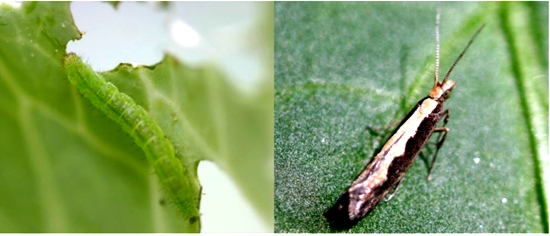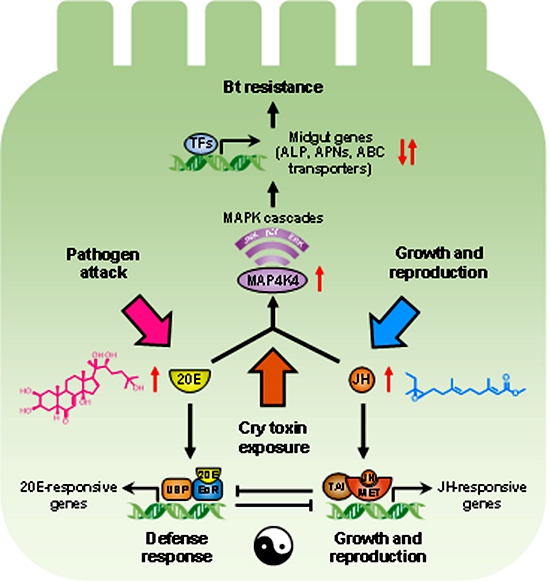Hormonal Regulation of Bt Resistance in the Diamondback Moth

Figure 1. The larva (left) and adult (right) of the diamondback moth, Plutella xylostella (L.).
The gram-positive soil bacterium Bacillus thuringiensis (Bt) is the most successful biopesticide that can produce insecticidal Cry toxins to kill insect pests, and transgenic crops expressing Bt insecticidal Cry toxins (Bt crops) have been planted worldwide. Although Bt products have provided unprecedented economic, environmental and social benefits, mounting field-evolved Bt resistance episodes seriously threaten world agricultural production and make it extremely important to clarify their resistance mechanisms. The diamondback moth, Plutella xylostella (L.), is a notorious global pest and is the first documented insect developing field-evolved resistance to Bt biopesticide, which makes it a good model to study Bt resistance mechanisms.
Here, prof. Guo Zhaojiang and Zhang Youjun from Institute of Vegetables and Flowers, Chinese Academy of Agricultural Sciences have published a paper in Nature Communications recently and demonstrated that the MAPK signaling pathway is a general switch for trans-regulatory mechanism of diverse midgut genes to counter Bt Cry1Ac toxin. More importantly, they have built upon the role of MAPK signaling pathway in Bt resistance development to link this response to the pleiotropic effects of dialogue between two important insect hormones 20-hydroxyecdysone (20E) and juvenile hormone (JH) and demonstrated that hormonal signaling plasticity is a general cross-kingdom strategy to fend off pathogenic attacks.

Figure 2. Model for insect hormones-mediated growth-defense tradeoffs orchestrating Cry1Ac resistance in P. xylostella.
This study reveals a complex response in insects to Bt intoxication. Through an increase in titer of the two abovementioned hormones, the insect would down-regulate the gut proteins that act as receptors for the Bt toxins while at the same time up-regulate paralogs that serve similar physiological functions (and thus maintain homeostasis) but could not act as receptors. In moths that have evolved resistance to Bt, some as yet unidentified mutations appear to have resulted in a constitutive activation of this response. Although the diamondback moth was the first insect to develop field resistance to Bt-based bioinsecticides, which have been used for less than a century, it is unlikely that this complex response has evolved solely as a result of the commercial use of these products. Instead, they presume that it has evolved as part of a natural/innate response to Bt, and/or some other challenges, over a much longer timeframe.
This work was supported by the National Natural Science Foundation of China (31630059; 31701813), the Central Public-interest Scientific Institution Basal Research Fund (IVF-BRF2020015), the Beijing Key Laboratory for Pest Control and Sustainable Cultivation of Vegetables and the Science and Technology Innovation Program of the Chinese Academy of Agricultural Sciences (CAAS-ASTIP-IVFCAAS).
By Guo Zhaojiang (guozhaojiang@caas.cn)
-
 Apr 18, 2024Opening Ceremony of the Training Workshop on Wheat Head Scab Resistance Breeding and Pest Control in Africa Held in CAAS
Apr 18, 2024Opening Ceremony of the Training Workshop on Wheat Head Scab Resistance Breeding and Pest Control in Africa Held in CAAS -
 Apr 03, 2024IPPCAAS Co-organized the Training Workshop on Management and Application of Biopesticides in Nepal
Apr 03, 2024IPPCAAS Co-organized the Training Workshop on Management and Application of Biopesticides in Nepal -
 Mar 28, 2024Delegation from the School of Agriculture and Food Science of University College Dublin, Ireland Visit to IAS, CAAS
Mar 28, 2024Delegation from the School of Agriculture and Food Science of University College Dublin, Ireland Visit to IAS, CAAS -
 Mar 25, 2024Director of World Food Prize Foundation visited GSCAAS
Mar 25, 2024Director of World Food Prize Foundation visited GSCAAS -
 Mar 20, 2024Institute of Crop Sciences (ICS) and Syngenta Group Global Seeds Advance Collaborative Research in the Seed Industry
Mar 20, 2024Institute of Crop Sciences (ICS) and Syngenta Group Global Seeds Advance Collaborative Research in the Seed Industry
